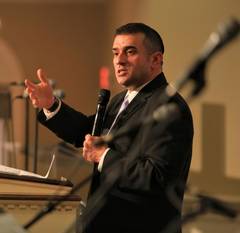- About Us
- Learning
- Resources
- Get Involved
- Membership
- Jobs
Scheduling Sadness
07/28/2020 05:41:15 PM
Rabbi Brent Spodek
| Author | |
| Date Added | |
| Automatically create summary | |
| Summary |
 |
The destruction of the Temple of Jerusalem; by Francesco Hayez |
The evening of Wednesday, July 29, 2020 marks the beginning of Tisha b’Av, the hardest day on the Jewish calendar. It literally means “The ninth day of the month of Av” and it marks the destruction of the two great temples that once stood in Jerusalem – the First Temple, which the Babylonians destroyed in 586 B.C.E. and the Second Temple which the Romans destroyed in 70 C.E. Over time it has come to mourn many of the tragedies which have befallen the Jewish people.
On an experiential level, Tisha b’Av is a day of intensive mourning. As on Yom Kippur, Jews traditionally abstain from food, drink and other joyful behaviors and additionally, take on practices of mourning such as sitting low to the ground. Most prominently, the day is liturgically marked by reading Eicha, the Book of Lamentations, which recounts the destruction of the First Temple. For those who are interested, we’ll be joining together with our friends at Bnai Jeshurun in New York to read the Book of Lamentations to begin the commemoration of Tisha B’Av.
On a conceptual level, Tisha b’Av consolidates mourning for a whole range of Jewish tragedies, from the destruction of the Temples to the expulsion of the Jews from Spain in 1492. It’s a day of pain, a day in which the imperative of hope is put aside. Judaism articulates the belief that the world can be better than it currently is, that an enslaved and oppressed people can ultimately go free. Optimism is part of the fabric of Judaism, yet all of us who have suffered loss know that optimism can gloss over suffering. When we endure tragedy, either personal or national, we know that we have to give pain its due before moving to recovery and rebuilding. Maya Angelou makes this beautifully clear when she writes in The Rock Cries Out to Us Today that
History, despite its wrenching pain,
Cannot be unlived, and if faced with courage,
Need not be lived again.
Tisha b’Av is so difficult because it is a day of suspended optimism, a day of trying to face pain with courage.
On a spiritual level, Tisha b’Av can be seen as marking the very beginning of the High Holiday season. Rabbi Alan Lew points out that on this day, we remember two great temples, grandiose in their bearing, that were seen as the very axis of the universe. They were tremendous and magnificent and now, more than 2,600 years after the destruction of the First Temple we continue to mourn what was and what might have been.
However, ten weeks from now, after we have marked Rosh HaShana, Yom Kippur and Sukkot, we will come to Simchat Torah and we will dismantle a sukkah, the barest sketch of a house, amid tremendous joy and celebration. We mourn when the grand aspirations are destroyed, yet when simple sketches vanish, leaving us with only the present moment, we celebrate.
Tisha b’Av can be seen as the beginning of the season in which we try to discern which visions of our lives and our world we actually want to tightly hold onto, such that they will cause us pain if they are not realized, and which visions we want to let evaporate so that we can feel the joy of the present moment.
As always, more information is available at www.myjewishlearning.com, and I hope that Tisha b’Av speaks to you, however you encounter it.
Shabbat shalom,
Rabbi Brent
Sat, October 25 2025
3 Cheshvan 5786
RABBI BRENT SPODEK

Join Our Mailing List
Privacy Settings | Privacy Policy | Member Terms
©2025 All rights reserved. Find out more about ShulCloud


